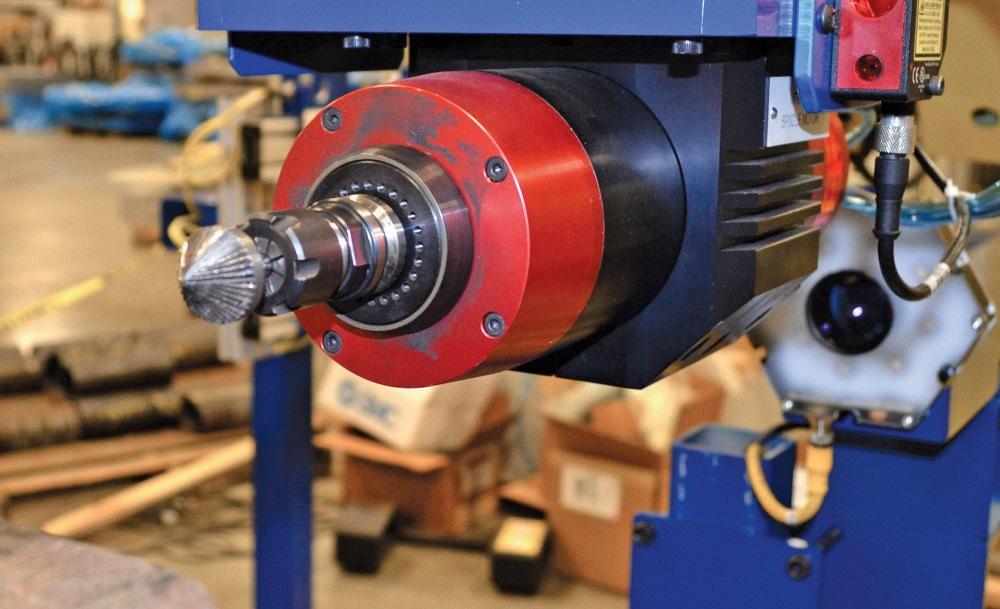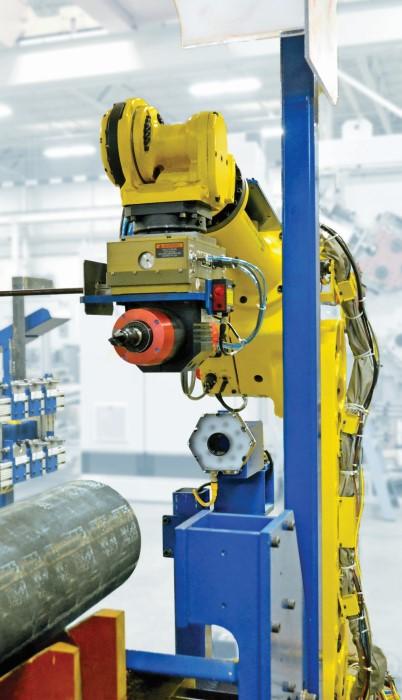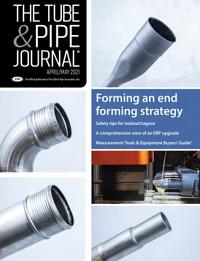- FMA
- The Fabricator
- FABTECH
- Canadian Metalworking
Categories
- Additive Manufacturing
- Aluminum Welding
- Arc Welding
- Assembly and Joining
- Automation and Robotics
- Bending and Forming
- Consumables
- Cutting and Weld Prep
- Electric Vehicles
- En Español
- Finishing
- Hydroforming
- Laser Cutting
- Laser Welding
- Machining
- Manufacturing Software
- Materials Handling
- Metals/Materials
- Oxyfuel Cutting
- Plasma Cutting
- Power Tools
- Punching and Other Holemaking
- Roll Forming
- Safety
- Sawing
- Shearing
- Shop Management
- Testing and Measuring
- Tube and Pipe Fabrication
- Tube and Pipe Production
- Waterjet Cutting
Industry Directory
Webcasts
Podcasts
FAB 40
Advertise
Subscribe
Account Login
Search
Automated chamfering system improves workplace safety for tube and pipe producers
Robotic foundation, vision system, and sensors provide safe, reliable system for metal removal
- By Eric Lundin
- April 20, 2021
- Article
- Tube and Pipe Production

Lacerations are a risk when handling tube and pipe fresh off a mill. Taylor-Winfield used a conventional concept, an automated chamfering system, and upgraded it to use a robot as a foundation and outfitted it with some of the latest sensor technology. The outcome is a versatile and robust system that serves as a platform for chamfering and other operations.
In the entire manufacturing sector, it would be hard to find a business that has it tougher than a tube or pipe producer. Raw material prices rise and fall almost without warning, domestic competition is challenging and foreign competition is worse, finding new employees is always a struggle, and making products that meet all of the manufacturing requirements while complying with customer requests isn’t easy. Doing it all safely and efficiently is a tall order. It’s no wonder that tube and pipe producers look for opportunities to automate tasks whenever they can.
Take chamfering, for instance. Chamfering the ends of every length of tube or pipe that rolls off a mill sounds like too big a task to take on, but indeed it’s necessary. The ends of tubular products, when cut off properly, present a big risk of laceration in downstream operations; chamfering the ends is a big help to the fabricators that handle tube and pipe straight from the mill.
When this job is carried out manually, everything about it is difficult. Spending an entire day trying to get consistent pipe chamfers with a manually operated tool can be a daunting task. If the worker gets fed up and quits, replacing him isn’t easy either. Manufacturers have hired all of the skilled labor they can find and usually have to settle for unskilled labor. Positions like this are tough to fill and keep filled.
Chamfering is nothing new, but carrying it out with the latest technology can make it seem like a brand-new, modern process. Taylor-Winfield Technologies Inc., Youngstown, Ohio, recently developed a robotic chamfering system that combines some of the latest sensors, hardware, and software to take the difficulty out of the task.
21st-century Technologies for a Conventional Job
Developing an automated cutting machine isn’t the company’s first rodeo. However, focusing on using the latest technologies combined with robots and safety concerns, led Taylor-Winfield to developing a customizable, flexible system that is being used in pipe processing mills today.
“Today’s robots, combined with modern sensor technology, are extremely flexible in their capabilities,” said Rory McDonnell, vice president of engineering at Taylor-Winfield.
With the new chamfering technology, after the clamping system automatically secures the pipe, the robot uses a vision system to scan the tube or pipe’s diameter and to determine just how round or out-of-round the product is. After gathering this information, the robot’s arm traces the exact contour of the circumference, using the tooling to impart a chamfer that is consistent with the circumference despite any inconsistency in the pipe’s shape. A debris removal system blows the chips out of the tube to be collected in a pan, and a laser displacement sensor does a 360-degree check to verify that the chamfer is complete. This sort of closed-loop concept is critical when a supplier wants or needs to provide 100% verification that a process was carried out.
When the next tube arrives at the station, the process starts over. If the next tube is a different diameter or shape and needs a different chamfering tool, operator intervention is not required. The robot does automatic tooling changeover.
The system gathers quite a few data points that can be fed into the company’s enterprise resource planning (ERP) system if desired. These include:
- Outside diameter.
- Inside diameter (if pipe).
- Product material.
- Spindle torque (measured by the current draw in amps).
- Chamfer feed rate.
- Cutting direction (clockwise or counterclockwise).
- Cutting force in the axial direction of the pipe.
- Total chamfering action (360 or 720 degrees).

In addition to providing the endless versatility provided by commercially available chamfering bits, the system is efficient; it relies very little on human intervention, using an automatic changeover system for exchanging bits.
More Than Meets the Eye
The robotic chamfering system’s capability is broader than it seems after an initial glance. First, the Taylor-Winfield team isn’t really limited in the robot brands it can use to develop a custom system for its customers.

Custom equipment manufacturer Taylor-Winfield has found that robotic technology provides the ideal level of flexibility for a tube and pipe chamfering platform.
“We’re a certified integrator of many of the major robotic systems manufacturers—Fanuc, Kawasaki, and Motoman,” McDonnell said.
Second, the system isn’t intended for chamfering only. A longtime custom equipment developer with substantial expertise in metal removal, the company considers this machine to be a platform more than a machine, one that can accommodate other processes, such as grinding, flash removal, deburring, and buffing.
Third, for scalability the company’s design team is prepared to develop a system that uses two robots rather than just one.
Fourth, on the shop floor, this robot—like most automated systems—isn’t a job killer, but a job creator. Decades ago every step along the road to automation was met by unending skepticism, and usually downright suspicion, from the workforce, and a few workers might still see such technologies as job killers these days. However, that perspective has been fading for some time. It sounds like a cliché, but robotics and automated systems do exactly what they’ve always been expected to do: They improve the workplace by taking over the most dangerous and monotonous jobs, like loading/unloading machines, painting, and basic welding. Metal removal is no exception. And as the shop floor becomes more sophisticated, it creates new opportunities. With more capable machines handling more tasks, workers need to tend those machines by swapping out tooling; setting up, fine-tuning, and tearing down temporary workcells; and, of course, programming robots.
About the Author

Eric Lundin
2135 Point Blvd
Elgin, IL 60123
815-227-8262
Eric Lundin worked on The Tube & Pipe Journal from 2000 to 2022.
About the Publication
Related Companies
subscribe now

The Tube and Pipe Journal became the first magazine dedicated to serving the metal tube and pipe industry in 1990. Today, it remains the only North American publication devoted to this industry, and it has become the most trusted source of information for tube and pipe professionals.
start your free subscription- Stay connected from anywhere

Easily access valuable industry resources now with full access to the digital edition of The Fabricator.

Easily access valuable industry resources now with full access to the digital edition of The Welder.

Easily access valuable industry resources now with full access to the digital edition of The Tube and Pipe Journal.
- Podcasting
- Podcast:
- The Fabricator Podcast
- Published:
- 04/16/2024
- Running Time:
- 63:29
In this episode of The Fabricator Podcast, Caleb Chamberlain, co-founder and CEO of OSH Cut, discusses his company’s...
- Trending Articles
Zekelman Industries to invest $120 million in Arkansas expansion

3D laser tube cutting system available in 3, 4, or 5 kW

Corrosion-inhibiting coating can be peeled off after use

Brushless copper tubing cutter adjusts to ODs up to 2-1/8 in.

HGG Profiling Equipment names area sales manager

- Industry Events
16th Annual Safety Conference
- April 30 - May 1, 2024
- Elgin,
Pipe and Tube Conference
- May 21 - 22, 2024
- Omaha, NE
World-Class Roll Forming Workshop
- June 5 - 6, 2024
- Louisville, KY
Advanced Laser Application Workshop
- June 25 - 27, 2024
- Novi, MI



























